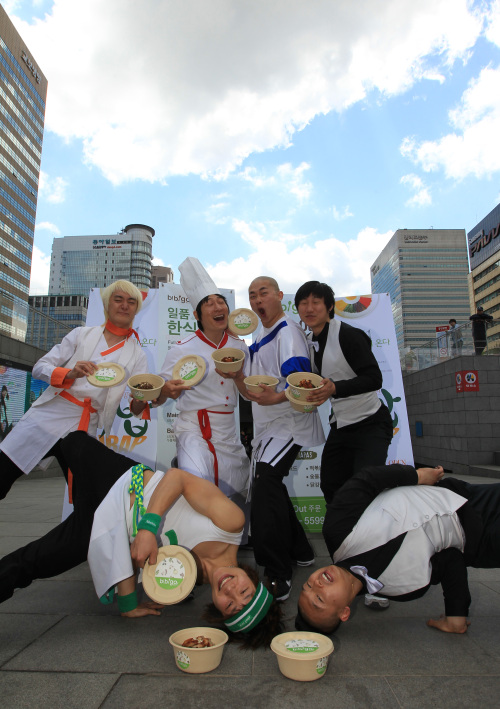Korean original non-verbal performances expand stages
Buoyed by a favorable reception from foreign audiences, Korea’s original non-verbal performances are expanding their stages both here and abroad.
“Nanta,” the best-known non-verbal performance “made” in Korea, kicked off its two-month-long Chinese tour last month. Visiting 16 cities, it is the longest touring show taken to China by a Korean performance team.
Based on events in the kitchen of a Korean restaurant, “Nanta” is mainly carried by percussive rhythms created by cooks drumming and banging different utensils such as knives, pans and chopping boards. The title of the show can be loosely translated as “messy beat.”
Buoyed by a favorable reception from foreign audiences, Korea’s original non-verbal performances are expanding their stages both here and abroad.
“Nanta,” the best-known non-verbal performance “made” in Korea, kicked off its two-month-long Chinese tour last month. Visiting 16 cities, it is the longest touring show taken to China by a Korean performance team.
Based on events in the kitchen of a Korean restaurant, “Nanta” is mainly carried by percussive rhythms created by cooks drumming and banging different utensils such as knives, pans and chopping boards. The title of the show can be loosely translated as “messy beat.”

The show, which premiered in October 1997, has been staged more than 19,000 times in about 252 cities and has been seen by around 6.14 million people. About 50 percent of the audience to its Seoul shows is foreign.
PMC Productions, the producer of “Nanta,” said that it is planning to open an 800-seat Nanta theater in Bangkok in June. It will have a year’s trial run and continue, depending on the response from the local audience.
“Jump,” another Korean non-verbal performance, is opening an exclusive theater in New York and will start as an open-run on May 9, soon after it finishes its current run in Honolulu, Hawaii.
This is the show’s second visit to the Big Apple ― it was staged in the Union Square Theater for 10 months in 2007-08, until the economic crisis struck.
The show revolves around a family whose members are all experts in some form of martial art, such as Taekwondo, or at least in acrobatics. Premiering in 2003, “Jump” is rapidly catching up with “Nanta.” It has been performed more than 7,000 times in about 63 cities, seen by 3 million people.
“Our goal is to become a long-running show off-Broadway like ‘Altar Boyz’ or ‘Stomp,’” said Kim Gyeong-hoon, president of Yegam, which produces “Jump.”
The status of non-verbal performances as a big attraction for foreign visitors continues to grow firmer.
“Nanta” recently opened its fifth exclusive theater in the Hongik University area in Seogyo-dong, central Seoul, following its theaters in Jeong-dong, Cheongdam-dong, Myeong-dong and Jeju-do.
Reflecting the freewheeling spirit of the artistic neighborhood, the special opening show “Nanta” held at the theater’s opening ceremony last week was full of small surprises such as a B-boy show and a unique version of “Nanta” with language.
“‘Nanta,’ which I gave birth to and Mr. Lee Gwang-ho, co-head of PMC, raised, is now 14 years old. We need your support so it can continue its growth in the future,” said Song Seung-hwan, actor and president of PMC Productions.
Yegam opened an exclusive theater last month for “Jump” in Jeju-do as well. It is the show’s second exclusive theater, following the one in Insa-dong, central Seoul.
A new non-verbal performance titled “Bibap,” to premier on May 27 in Seoul, gave Seoulites a brief preview, showcasing some highlight scenes in Gwanghwamun last Thursday lunchtime.

Produced by CJ E&M, “Bibap” merges all sorts of performances including b-boying, acrobatics, martial arts and a cappella to tell a story of young cooks who cook bibimbap, a traditional Korean dish of rice mixed with vegetables and meat.
Though the proliferation of foreigner-attracting non-verbal shows is certainly welcome, some point out a need to diversify the content.
“Bibap,” for example, is quite similar to “Nanta,” perhaps because it is led by the same director, Choi Cheol-gi. Though it features more dance routines, the show basically relies on actors banging cooking utensils.
“I have only seen 15 minutes of it but it feels as if I have already seen the whole show,” said Oh, a 30-year-old office worker who came to see the show during his lunch break.
The rising popularity of “Miso,” a non-verbal performance which offers a compact presentation of 10 different kinds of traditional dances, five traditional games and a wedding ritual, is welcome news for this reason.
Started in 1997, the show was not as popular as the dynamic “Nanta” or “Jump,” but started gaining interest as it changed its main story line last year to one based on a well-known Korean folktale, “The Tale of Chunhyang.”
Audience attendance doubled after the change and the show started to get invitations for overseas performances.
“We needed a show that can represent the Korean sentiment. ‘Miso’ is meaningful because it can entertain foreigners while showing them our culture,” said Kim Seong-dong, a Grand National Party legislator, at a ceremony held this month to celebrate the 1st anniversary of Chongdong Theater’s renovation as an exclusive theater for “Miso.”
By Park Min-young (claire@heraldcorp.com)


![[AtoZ into Korean mind] Humor in Korea: Navigating the line between what's funny and not](http://res.heraldm.com/phpwas/restmb_idxmake.php?idx=644&simg=/content/image/2024/04/22/20240422050642_0.jpg&u=)
![[Exclusive] Korean military set to ban iPhones over 'security' concerns](http://res.heraldm.com/phpwas/restmb_idxmake.php?idx=644&simg=/content/image/2024/04/23/20240423050599_0.jpg&u=20240423183955)



![[Graphic News] 77% of young Koreans still financially dependent](http://res.heraldm.com/phpwas/restmb_idxmake.php?idx=644&simg=/content/image/2024/04/22/20240422050762_0.gif&u=)

![[Herald Interview] Why Toss invited hackers to penetrate its system](http://res.heraldm.com/phpwas/restmb_idxmake.php?idx=644&simg=/content/image/2024/04/22/20240422050569_0.jpg&u=20240422150649)




![[Exclusive] Korean military to ban iPhones over security issues](http://res.heraldm.com/phpwas/restmb_idxmake.php?idx=652&simg=/content/image/2024/04/23/20240423050599_0.jpg&u=20240423183955)



![[Today’s K-pop] Ateez confirms US tour details](http://res.heraldm.com/phpwas/restmb_idxmake.php?idx=642&simg=/content/image/2024/04/23/20240423050700_0.jpg&u=)